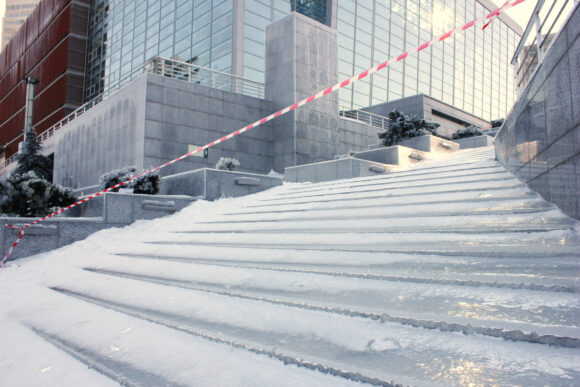Winter Weather Preparation for Building Owners and Fleets

This post is part of a series sponsored by IAT Insurance Group.
Winter weather is just around the corner. To reduce the risk of hazards, winter preparation is essential. Now is the time for building mangers to ready their premises and for drivers to winterize and equip their vehicles for winter driving conditions. Now is also a great time for fleet managers to remind drivers of safe driving techniques during winter conditions.
Wintertime building preparation
As weather-related risks head our way, building owners and facility managers should review safety policies and procedures, update incident response plans and ready their premises. Here are some steps to do just that:
Inspect your premises. Check the grounds daily. Examine sidewalks and parking lots for slip and fall hazards, and record all fixes and repairs. This documentation proves that precautions were met to mitigate incidents and demonstrates a proactive approach to managing those hazards. If security cameras are in place, make sure their lens is clear and the system is operating accordingly. Cameras are a deterrent to trespassing and can provide a record of activity on your property.
Light the way. Poor lighting increases the risk of slips, trips and falls. Illuminate walkways, staircases, ramps and hallways. Make sure outdoor lights are working and programmed to turn on at dusk.
Prepare for ice. Rain, snow and ice creates slip hazards. Ice melting products and non-slip runners can greatly reduce these hazards. Make sure downspouts, canopies and overhangs do not drain onto pedestrian traffic areas. Gutters and downspouts should also be cleaned before winter arrives.
Maintain your grounds. Maintain exterior steps, ramps, walkways, entry and exit points. Clear snow and ice from walkways and parking lots as it accumulates. Internally, use moisture-absorbent mats at entry points with beveled edges and non-slip backing to prevent sliding. Rotate wet rugs with dry rugs throughout the day. Clean up spills immediately and display “wet floor” or similar signage as needed.
Prepare for cold weather calamities. Prepare for freezing pipes, interior water losses from heavy rainfall, and clogged storm and roof drains with preventative maintenance. Check heating systems and make sure smoke detectors and CO2 monitors are working well.
Preparing equipment and vehicles
Before driving in adverse weather conditions, all drivers should perform the following safety checks and measures on their vehicles:
Check tire treads and pressure, as worn tires cause many vehicle accidents — especially in wet, snowy or icy conditions.
Make sure the defrost, heat and windshield wipers are working and anti-freeze is filled.
Keep the fuel level above half a tank.
Maintain an emergency kit inside the vehicle that includes a shovel, heavy blanket, flashlight, batteries, snacks, water, gloves, boots, ice scraper, and jumper cables.
Have tire chains ready if you are in an area where snow is common or chains are mandated by law. Drivers should know how to install the chains before they are needed, so a quick reminder/training session in your next safety meeting may be in order.
Winter driving tips
When transporting loads in adverse weather conditions, fleets should encourage their drivers to do the following:
Increase their following distance by three to four times. Approximately 1.7 million rear-end collisions occur on U.S. roads each year.[1]
Lower speed to half under snowy conditions.[2]
Avoid sudden movements in steering, accelerating and braking, etc., to maintain traction.
Allocate more time for trips.
Watch out for black ice. Monitoring windows for ice buildup is a good indication of what’s happening on the road. Another is when vehicles no longer have spray coming off their tires. Moisture on the road can be become ice as the temperature drops.
Be aware that other drivers may not be familiar with winter driving. They may be traveling well below the posted speed limit, or the opposite, driving too fast for the conditions. Be patient and careful around others who may not be professional drivers.
Some additional recommendations include closely following the forecast, checking the latest travel condition information on the National Highway Administration’s “511” hotline, identifying potential stop areas, and waiting until hazardous conditions pass.
And remember, “No load is worth your life.”
ASK A LOSS CONTROL REPRESENTATIVE
Have a question on how to mitigate risk? Email losscontroldirect@iatinsurance.com for a chance to see your question answered in a future blog.
By Nick Martin and Jared Fritts
[1] The Washington Post “There are about 1.7 million year-end collisions on U.S. roads each year. Here’s how to stop them,” June 8, 2015.
[2] Federal Motor Carrier Safety Administration “CMV Driving Tips – Too Fast for Conditions,” February 11, 2015.
Was this article valuable?
Yes
No
Here are more articles you may enjoy.
The most important insurance news,in your inbox every business day.
Get the insurance industry’s trusted newsletter





